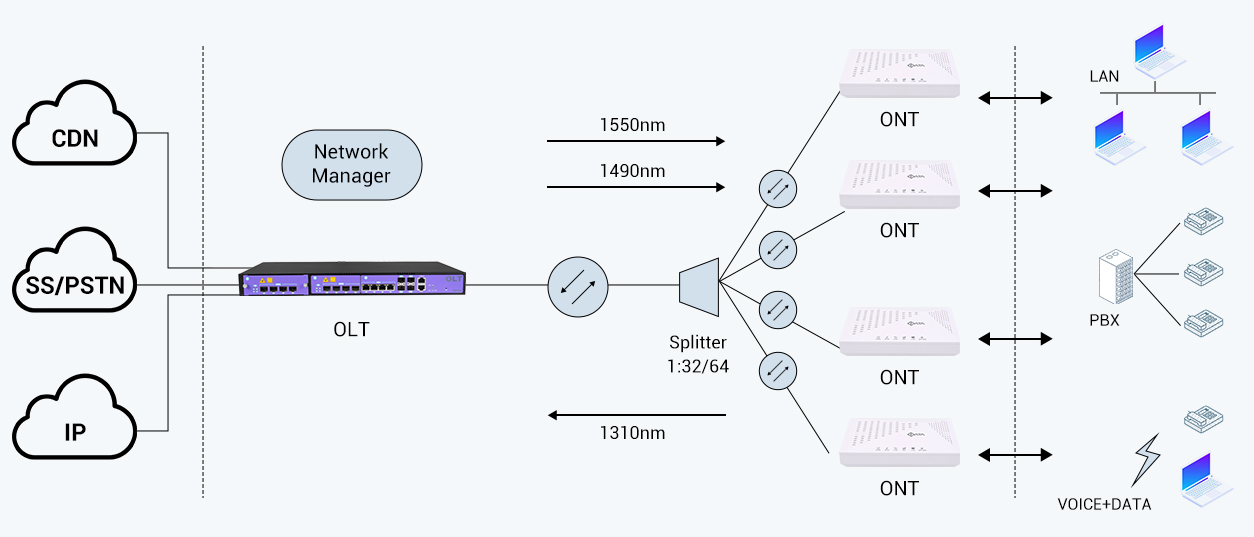Passive Optical Network (PON) is a highly significant category of fiber-optic access systems that holds a dominant position in the access market. GPON and EPON are two classifications of PON. The main difference between GPON and EPON lies in the protocols used for upstream and downstream communication. This article will sequentially introduce PON, GPON, and EPON.
PON is a type of fiber-optic network that employs only passive components such as fiber optics, PON splitters, and combiners, without active components like amplifiers, repeaters, or shaping circuits. Consequently, the cost of PON networks is significantly lower compared to networks using active components, but its coverage is limited by signal strength, resulting in a shorter reach. Active Optical Networks (AON) can cover distances of around 100 kilometers (62 miles), whereas PON is typically limited to fiber cable lengths of up to 20 kilometers (12 miles). PON is also known as Fiber to the Home (FTTH) networks.
A typical PON setup is a point-to-multipoint (P2MP) network, where a Central Office Line Terminal (OLT) in the service provider facility distributes television or internet services to as many as 16 to 128 customers through individual fiber lines. A splitter divides a single optical signal into multiple equal but lower-powered signals, distributing them to users. Optical Network Units (ONUs) terminate the PON at customer homes. ONUs often communicate with Optical Network Terminals (ONTs), which can be a single device.

GPON utilizes Wavelength Division Multiplexing (WDM), allowing a single optical fiber to carry both upstream and downstream data. Downstream data transmission occurs at a wavelength of 1490 nm, while upstream data transmission takes place at 1310 nm.
Although each ONU receives a full downstream rate of 2.488 Gbits/s, GPON employs a Time Division Multiple Access (TDMA) format to allocate specific time slots to each user. Bandwidth is partitioned, ensuring each user receives a portion, such as 100 Mbits/s, depending on how the service provider allocates bandwidth. The upstream rate is less than the maximum rate as it is shared among other ONUs in the TDMA scheme. The distance and delay for each user are determined by the OLT, which then provides a method for assigning upstream data slots for each user using software. A typical splitting ratio for a single optical fiber is 1:32 or 1:64, meaning a single fiber can serve up to 32 or 64 users. In some systems, the splitting ratio can go up to 1:128.
EPON 802.3ah is based on Ethernet standard 802.3 and specifies a similar passive optical network with a reach of up to 20 kilometers. EPON employs WDM with the same optical frequencies as GPON and TDMA. The original line data rates for both upstream and downstream directions are 1.25 Gbits/s.
EPON technology provides bidirectional 1 Gb/s links, with a downstream wavelength of 1490 nm and an upstream wavelength of 1310 nm, while reserving 1550 nm for future expansion or additional services. EPON is fully compatible with other Ethernet standards, so there's no need for encapsulation or conversion when connected to an Ethernet-based network at either end. Using the same Ethernet frames, the payload can be up to 1518 bytes. As Ethernet is the primary networking technology used in Local Area Networks (LANs) and Metropolitan Area Networks (MANs), no protocol conversion is necessary.
PON is used to deliver triple-play services to users, including television and internet services. The lower cost of passive components means simpler systems with fewer components prone to failures or requiring maintenance. The main drawback is the shorter reach, usually not exceeding 12 miles or 20 kilometers. As the demand for faster internet services and more video content continues to grow, PON is becoming increasingly popular. The era of PON has begun, ushering in a new era of access networks.
Experience top-tier network connectivity with C-Data's PON solutions. As pioneers in the industry, our PON technology guarantees superior performance and reliability. Quality First is our commitment, ensuring that our PON offerings stand out for their efficiency and dependability. Upgrade your network with C-Data's PON solutions and enjoy a cutting-edge, quality-driven connectivity experience. Choose PON with confidence, choose C-Data for a network that prioritizes excellence.